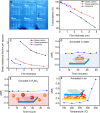Ultra-smooth glassy graphene thin films for flexible transparent circuits
- PMID: 28138535
- PMCID: PMC5262465
- DOI: 10.1126/sciadv.1601574
Ultra-smooth glassy graphene thin films for flexible transparent circuits
Abstract
Large-area graphene thin films are prized in flexible and transparent devices. We report on a type of glassy graphene that is in an intermediate state between glassy carbon and graphene and that has high crystallinity but curly lattice planes. A polymer-assisted approach is introduced to grow an ultra-smooth (roughness, <0.7 nm) glassy graphene thin film at the inch scale. Owing to the advantages inherited by the glassy graphene thin film from graphene and glassy carbon, the glassy graphene thin film exhibits conductivity, transparency, and flexibility comparable to those of graphene, as well as glassy carbon-like mechanical and chemical stability. Moreover, glassy graphene-based circuits are fabricated using a laser direct writing approach. The circuits are transferred to flexible substrates and are shown to perform reliably. The glassy graphene thin film should stimulate the application of flexible transparent conductive materials in integrated circuits.
Keywords: Flexible; conducting; glassy graphene; graphene; laser direct writing; transparent; ultra-smooth.
Figures




References
-
- Rogers J. A., Someya T., Huang Y., Materials and mechanics for stretchable electronics. Science 327, 1603–1607 (2010). - PubMed
-
- Sekitani T., Nakajima H., Maeda H., Fukushima T., Aida T., Hata K., Someya T., Stretchable active-matrix organic light-emitting diode display using printable elastic conductors. Nat. Mater. 8, 494–499 (2009). - PubMed
-
- Lipomi D. J., Vosgueritchian M., Tee B. C.-K., Hellstrom S. L., Lee J. A., Fox C. H., Bao Z., Skin-like pressure and strain sensors based on transparent elastic films of carbon nanotubes. Nat. Nanotechnol. 6, 788–792 (2011). - PubMed
-
- Xu F., Zhu Y., Highly conductive and stretchable silver nanowire conductors. Adv. Mater. 24, 5117–5122 (2012). - PubMed
-
- Pan S., Yang Z., Chen P., Deng J., Li H., Peng H., Wearable solar cells by stacking textile electrodes. Angew. Chem. Int. Ed. 53, 6110–6114 (2014). - PubMed
LinkOut - more resources
Full Text Sources
Other Literature Sources

